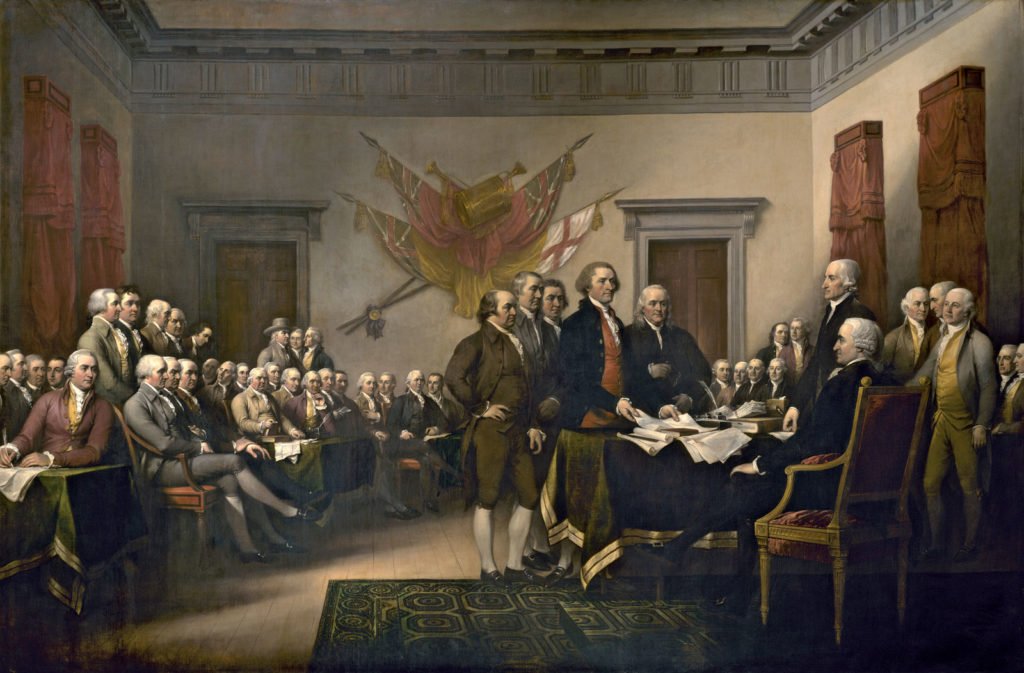A Straightforward Path to a Peaceful and Lawful Dissolution.

On this 4th of July, it is imperative for historical Americans to not only recall the Independence Days of years gone by, once one of the most joyful and exuberant days of the summer calendar, but to also reflect upon the terrible sacrifices willingly made by those who fought for a free and independent country. And even more fittingly, as we look out upon the desolation of a bereft nation, we historical Americans need to meaningfully engage for the orderly dissolution of this post-American USA, with at least one historical American republic established from its remnants. That is, on this Independence Day, it is incumbent upon us to begin with resolute steps toward a new independence from an increasingly despotic order.
There are many received truths when it comes to formal constitutional amendment. We have all learned that it is extraordinarily difficult to amend or revise the Constitution, a truism purportedly proven in that only twenty-seven amendments have been formally adopted over a span of 230 years. It is thus useful to take a closer look at the actual language of Article V, which sets forth the procedure for amendment:
“The Congress, whenever two thirds of both houses shall deem it necessary, shall propose amendments to this Constitution, or, on the application of the legislatures of two thirds of the several states, shall call a convention for proposing amendments, which, in either case, shall be valid to all intents and purposes, as part of this Constitution, when ratified by the legislatures of three fourths of the several states, or by conventions in three fourths thereof, as the one or the other mode of ratification may be proposed by the Congress; provided that no amendment which may be made prior to the year one thousand eight hundred and eight shall in any manner affect the first and fourth clauses in the ninth section of the first article; and that no state, without its consent, shall be deprived of its equal suffrage in the Senate.”
Article V, United States Constitution
We are all hopefully familiar with the mechanism of 2/3 Congressional approval, followed by ratification by 3/4 of the states (though the notion of state conventions may seem a bit foreign). But what about this “constitutional convention” language? Here we need to set aside any received truths and look to the plain language of Article V.
We have all been trained, perhaps in history or civics class, perhaps by the media, perhaps by the mandarins of “social media,” to believe that a constitutional convention is a functional impossibility, that it would result in chaos, that it is a kooky idea pushed by conspiracy theorists, or that it would be driven by right-wing authoritarians seeking to impose their ideology upon the nation writ large. (As to the last notion, if, at this point in 2020, you are not clear on the political orientation of the authoritarians seeking to impose their ideology upon the nation writ large, then you need to get another cup of coffee and fully awaken from your slumber.)
The language of Article V authorizing a constitutional convention mandates that one be called by Congress “on the application of the legislatures of two thirds of the several states.” As Hamilton explained in Federalist 85 (this is before he became a hip-hop star): “The words of this article are peremptory. The Congress ‘shall call a convention.’ Nothing in this particular is left to the discretion of that body.”
And over the last 230 years, states have called for a convention hundreds of times, with scholars unclear as to the exact number. The American Legislative Exchange Council (ALEC), for example, estimates that “more than seven hundred” such convention applications have been passed by state legislatures. So why then have we not had a convention? For the simple reason that we have been misreading the plain language of Article V.
A model resolution by ALEC for a convention on the topic of a balanced budget amendment provides an excellent illustration of the modern miscomprehension of Article V. The ALEC “convention proposal,” now adopted by several states, asserts that it shall only be valid as a mechanism to call a convention if thirty-four states pass single-subject resolutions on the same topic, and that it shall be “null and void” in support of anything other than that “specific and exclusive purpose.” Nothing in Article V allows for this limitation.
Time and again, states have fallen for this “single-subject fallacy,” uncritically calling for a convention solely within the context of a constitutional amendment on a single topic. Texas, for example, recently called for a convention for amendments limiting federal spending and federal power. However, Article V simply does not limit a constitutional convention to a single topic. Not only is this contrary to the article’s plain language, which speaks of a convention for “proposing amendments” (plural), but it is inimical to the entire idea of a convention: Why would the nation hold a constitutional convention if not to address multiple structural issues in its governance?
This is, in fact, the peril of which law professors warn us, the proverbial “runaway convention.” In this vision, a constitutional convention “turns into a true constitutional convention,” that is, that the people (and, naturally, various and sundry interest groups) would have the ability to reconstitute the political order. In effect, it is widely-conceded that a constitutional convention would not necessarily be subject to the constraints of a single subject, and could provide for a new political framework for the USA. The reasoning here is that although Article V does not differentiate between the ratification procedure for proposed amendments passed by convention, a constitutional convention, by its very nature, may start tabula rasa with its own rules and ratification procedure. After all, the nation has only had one constitutional convention in its history, and during that Philadelphia summer in 1787, the assembly certainly did not consider itself bound by the Articles of Confederation. And if everything truly is on table, does that not necessarily include secession, partition, or dissolution? Is not a chance for an amicable split exactly what we are looking for?
But the “single-subject fallacy” does not only relate to the conduct of a convention itself. Critically, the mechanism for calling a convention in the first place must also be understood with reference to the plain language of Article V. That article simply does not allow states, in their resolutions for a constitutional convention, to attempt to limit such a convention to a single topic. In other words, a resolution for a convention is a resolution for a convention, not a resolution for a convention on any particular subject: Any state resolution language purporting to limit the call to a single topic is simply surplusage. Accordingly, once thirty-four states have called for a constitutional convention, it is incumbent upon Congress to call that convention.
Of the hundreds of state resolutions passed, many are larded with expiration or rescission language, the effective of which is unclear — but many others are unambiguously valid. By one estimate, forty-two states currently have Article V resolutions for a convention pending. While by any mathematical measure, that should be enough, nothing so weighty is self-executing. So we just need a single state to force the issue by unambiguously demanding the right to a convention. For this purpose, the Dissolutionist has prepared a straightforward resolution to accomplish this very purpose. With the requisite number of resolutions already in place, all we need is a concerted effort by a single obliging legislature in formally adopting the Dissolution’s resolution. (Are you listening, Texas?)
There is little doubt that the Left would attempt to use a constitutional convention to impose its tyrannical vision of “social justice” upon the entire USA. That’s just what they do. But patriots need not go along. A free-wheeling convention would likewise allow for a peaceable dissolution, with at least one heritage America birthed from the wreckage. And gives us one hell of a lot better odds than we have now. What, exactly, do we have to lose at this point?
On this Independence Day, recall the terrible suffering that our Founding Fathers endured so that America could be free and independent. Not just a gentry offering up their lives, fortunes, and sacred honor, but a youthful Nathan Hale giving his “one life for his country,” and the soldiers at Valley Forge. As an American patriot, all that is asked of you, for now, is to download the resolution and send to your state legislators.
Jan Kezen, USA, July 4, 2020 (minor rev. July 5, 2020; substantial rev. July 6, 2020).
